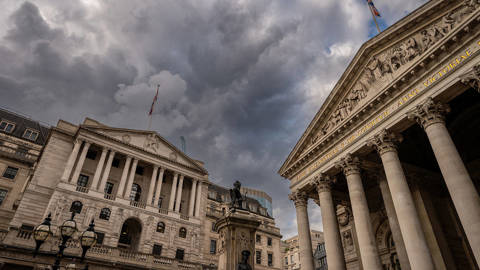On average, higher debt correlates with lower economic growth. This is what studies by the IMF, the Bank for International Settlements, and Reinhart-Rogoff show. Causality could run both ways, especially if more debt is piled upon existing debt in post-crisis efforts to restart growth. However, the first movement, which actually fits the prediction of textbook macroeconomics, is from unchecked debt to slower growth and stagnation.
Up to a certain point, public borrowing smooths a country’s investments in public goods, technology, and education across generations without immediate, drastic consequences on taxation and the private borrowing of current generations. Up to a point, also, public borrowing stimulates private investment by easing general credit conditions. It facilitates growth, and -- to the extent it is desirable -- can help stabilise an economy.
In the absence of enforceable national or international budget-balancing laws, there is literally no limit on the size of the debt that the government of a country with its own currency can owe to citizens and foreigners. In a mythical world of constantly stable economic growth and fiscal revenue, debt can be rolled over until it disappears off the radar screen.
In practice, large debt has proved dangerous. The constraints that debt can impose on state policy make it the most common source of sovereign-level risk.
Past a certain point, debt-financed deficits are no longer a free lunch. Public borrowing and servicing costs begin, as economists say, to ‘crowd out’ fiscal space and funds that would otherwise be available to private borrowers who finance investments. Debt becomes excessive when used to paper-over underlying sources of instability or stagnation. Worst of all, too much debt produces fragility by leaving countries unprepared for unexpected (though historically predictable) downward turns, bad luck, war, shocks, hard landings.
A compounding factor is that market economies never stand still. New demands on public expenditure appear -- adaptation to technology, change in comparative trade advantage, employment structure, intergenerational dependency ratios, climate.
In a classic 1994 macro primer, Rudiger Dornbusch and Stanley Fischer summed up the unpleasant arithmetic: “The public debt becomes so large, interest payments take up so much of the budget, and crowding out becomes so pervasive that some action needs to be taken to balance the budget. This might involve inflation, special taxes, or highly unpopular major cuts in government spending. As an extreme measure, the government might even write down the value of the public debt.” In the absence of growth, and without political leeway for growth-restoring structural reform, a paralysed state can in the last resort print money to meet short-run repayment obligations.
What is the inflection point at which growth slows and governments really struggle to service debt? The most up-to-date recalculation of best available cross-country historical data sets by Reinhart-Rogoff was produced in early May 2013 under the fierce glare of public anger-attention. Median growth drops from 2.8% to 1.8% when debt-to-GDP rises from 60% to 90%. This ‘threshold’ is a helpful statistical guide, not a cliff.
Why does public debt and lower national growth correlate in this way? Reinhart-Rogoff have a concept of ‘debt intolerance’ to describe institutional conditions associated with the propensity to borrow instead of reforming an economy. More universal inferences might be drawn directly by analogy with private borrowing. Behavioural responses to public debt distress show similarity to those of private borrowers (individuals, corporations, banks).
In normal circumstances, a firm -- unlike a government -- must actually pay for its mistakes. This is the source of the greater efficiency of private business. A bad decision in the management of a firm’s liabilities could result in bankruptcy and liquidation. Even non-specialists usually realise that, however necessary it is, debt does magnify the risk one takes. When assessing the risks inherent in an innovation or an investment the capitalist must decide how much borrowed money it requires. Without retained earnings, capital, and equity, the businessman will be far more cautious. The extent to which he is willing to borrow-to-invest is likewise influenced by the business climate and the tax burden.
In The Bankers’ New Clothes, which primarily looks at systemic risks posed by banks’ extreme dependence on borrowing (rather than funding assets from equity), Anat Admati and Martin Hellwig offer general insights about behavioural effects of mis-borrowing: “Borrowers may make different decisions because of their overhanging debt than they would have made had they not been indebted … or if their burden of debt was lighter”.
Further: “Distressed borrowers may become excessively cautious or excessively reckless. Both of these behaviours can be costly to borrowers, creditors, and third parties”. Behaviours of borrowers in distress are “distorted and potentially dangerous”. At best they will not make investments they would have made, will be less competitive, less successful.
Sovereign borrowers are not so different. Sovereigns do not face the threat of extinction by liquidation because of risky borrowing. Yet their debt crises with default or retrenchment are no less existential. Because of large sovereign debts, societies and polities face deeply disruptive distributional conflict, austerity and structural shock, populist retributions, scapegoating, loss of international standing.
Are not the following, at root, behaviours that directly flow from distressed borrowing: US political gridlock over spending and taxation; trans-European gridlock over vital questions of collective responsibility, liability, and regulation; political upheaval in countries of the European periphery; an unprecedented shock-and-awe monetary policy experiment in Japan?
The stakes are high. Both reckless and excessively cautious behaviours are in evidence. Distressed country debtors take chances, they gamble, act dishonestly, play toxic games with creditors, waste scarce resources, seek new geopolitical alliances, tolerate bellicosity towards partner countries, fabricate economic data, ignore fraud, conceal bank insolvency.
Others pull their heads in and hope eventually to grow their way out of debt; they are joyful when their academics weave pseudo technical narratives of invulnerability.
Like businesses which dampen their entrepreneurial spirit because of large debt, distressed sovereign borrowers tend to go cool on institutional innovation at the very moment it is most needed.
Some behaviours are paradoxically reckless caution. Non-enforcement of rules, experimentation with ‘painless quick fixes’, and deferment of the structural reforms needed to create competitiveness and restore growth; they may look like the pragmatic caution of embattled politicians who have the heavy responsibility of caring for sickly economies.
In reality, this cautious inaction is recklessness that worsens the situation. In Greg Mankiw’s words, failure to get the debt-to-GDP ratio down will leave the US “too vulnerable when the next catastrophe strikes”. In Europe, reckless caution prevents compromise with creditors and friendly countries that could help restore economic health to distressed borrowers.
Extra reading:
Cecchetti, Mohanty, Zampolli (2011) ‘The real effects of debt’, Bank for International Settlements.










On average, higher debt correlates with lower economic growth. This is what studies by the IMF, the Bank for International Settlements, and Reinhart-Rogoff show. Causality could run both ways, especially if more debt is piled upon existing debt in post-crisis efforts to restart growth. However, the first movement, which actually fits the prediction of textbook macroeconomics, is from unchecked debt to slower growth and stagnation.
Up to a certain point, public borrowing smooths a country’s investments in public goods, technology, and education across generations without immediate, drastic consequences on taxation and the private borrowing of current generations. Up to a point, also, public borrowing stimulates private investment by easing general credit conditions. It facilitates growth, and -- to the extent it is desirable -- can help stabilise an economy.
In the absence of enforceable national or international budget-balancing laws, there is literally no limit on the size of the debt that the government of a country with its own currency can owe to citizens and foreigners. In a mythical world of constantly stable economic growth and fiscal revenue, debt can be rolled over until it disappears off the radar screen.
In practice, large debt has proved dangerous. The constraints that debt can impose on state policy make it the most common source of sovereign-level risk.
Past a certain point, debt-financed deficits are no longer a free lunch. Public borrowing and servicing costs begin, as economists say, to ‘crowd out’ fiscal space and funds that would otherwise be available to private borrowers who finance investments. Debt becomes excessive when used to paper-over underlying sources of instability or stagnation. Worst of all, too much debt produces fragility by leaving countries unprepared for unexpected (though historically predictable) downward turns, bad luck, war, shocks, hard landings.
A compounding factor is that market economies never stand still. New demands on public expenditure appear -- adaptation to technology, change in comparative trade advantage, employment structure, intergenerational dependency ratios, climate.
BLACK FRIDAY SALE: Subscribe for as little as $34.99
Subscribe now to gain access to insights and analyses from the world’s leading thinkers – starting at just $34.99 for your first year.
Subscribe Now
In a classic 1994 macro primer, Rudiger Dornbusch and Stanley Fischer summed up the unpleasant arithmetic: “The public debt becomes so large, interest payments take up so much of the budget, and crowding out becomes so pervasive that some action needs to be taken to balance the budget. This might involve inflation, special taxes, or highly unpopular major cuts in government spending. As an extreme measure, the government might even write down the value of the public debt.” In the absence of growth, and without political leeway for growth-restoring structural reform, a paralysed state can in the last resort print money to meet short-run repayment obligations.
What is the inflection point at which growth slows and governments really struggle to service debt? The most up-to-date recalculation of best available cross-country historical data sets by Reinhart-Rogoff was produced in early May 2013 under the fierce glare of public anger-attention. Median growth drops from 2.8% to 1.8% when debt-to-GDP rises from 60% to 90%. This ‘threshold’ is a helpful statistical guide, not a cliff.
Why does public debt and lower national growth correlate in this way? Reinhart-Rogoff have a concept of ‘debt intolerance’ to describe institutional conditions associated with the propensity to borrow instead of reforming an economy. More universal inferences might be drawn directly by analogy with private borrowing. Behavioural responses to public debt distress show similarity to those of private borrowers (individuals, corporations, banks).
In normal circumstances, a firm -- unlike a government -- must actually pay for its mistakes. This is the source of the greater efficiency of private business. A bad decision in the management of a firm’s liabilities could result in bankruptcy and liquidation. Even non-specialists usually realise that, however necessary it is, debt does magnify the risk one takes. When assessing the risks inherent in an innovation or an investment the capitalist must decide how much borrowed money it requires. Without retained earnings, capital, and equity, the businessman will be far more cautious. The extent to which he is willing to borrow-to-invest is likewise influenced by the business climate and the tax burden.
In The Bankers’ New Clothes, which primarily looks at systemic risks posed by banks’ extreme dependence on borrowing (rather than funding assets from equity), Anat Admati and Martin Hellwig offer general insights about behavioural effects of mis-borrowing: “Borrowers may make different decisions because of their overhanging debt than they would have made had they not been indebted … or if their burden of debt was lighter”.
Further: “Distressed borrowers may become excessively cautious or excessively reckless. Both of these behaviours can be costly to borrowers, creditors, and third parties”. Behaviours of borrowers in distress are “distorted and potentially dangerous”. At best they will not make investments they would have made, will be less competitive, less successful.
Sovereign borrowers are not so different. Sovereigns do not face the threat of extinction by liquidation because of risky borrowing. Yet their debt crises with default or retrenchment are no less existential. Because of large sovereign debts, societies and polities face deeply disruptive distributional conflict, austerity and structural shock, populist retributions, scapegoating, loss of international standing.
Are not the following, at root, behaviours that directly flow from distressed borrowing: US political gridlock over spending and taxation; trans-European gridlock over vital questions of collective responsibility, liability, and regulation; political upheaval in countries of the European periphery; an unprecedented shock-and-awe monetary policy experiment in Japan?
The stakes are high. Both reckless and excessively cautious behaviours are in evidence. Distressed country debtors take chances, they gamble, act dishonestly, play toxic games with creditors, waste scarce resources, seek new geopolitical alliances, tolerate bellicosity towards partner countries, fabricate economic data, ignore fraud, conceal bank insolvency.
Others pull their heads in and hope eventually to grow their way out of debt; they are joyful when their academics weave pseudo technical narratives of invulnerability.
Like businesses which dampen their entrepreneurial spirit because of large debt, distressed sovereign borrowers tend to go cool on institutional innovation at the very moment it is most needed.
Some behaviours are paradoxically reckless caution. Non-enforcement of rules, experimentation with ‘painless quick fixes’, and deferment of the structural reforms needed to create competitiveness and restore growth; they may look like the pragmatic caution of embattled politicians who have the heavy responsibility of caring for sickly economies.
In reality, this cautious inaction is recklessness that worsens the situation. In Greg Mankiw’s words, failure to get the debt-to-GDP ratio down will leave the US “too vulnerable when the next catastrophe strikes”. In Europe, reckless caution prevents compromise with creditors and friendly countries that could help restore economic health to distressed borrowers.
Extra reading:
Cecchetti, Mohanty, Zampolli (2011) ‘The real effects of debt’, Bank for International Settlements.